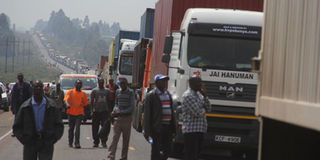Why slow speeds are increasingly more dangerous

A long queue of vehicles of stranded motorists, at Ngeria Trading Centre, on the Eldoret-Nakuru Highway. PHOTO | JARED NYATAYA
What you need to know:
- The likely scenario was this: The line of cars was caused by a vehicle travelling at 30kph (on an open section of a Trans-African Highway where an ambient speed at least two or three times higher would be modest and should be mandatory).
- The root cause, then, was not too much speed, but too little.
- Next, the crawler probably had some ditherers in its wake, making overtaking difficult and making the proper one-at-a-time sequence of overtaking impractical.
A mid-sized bus was overtaking a crawling queue of traffic when one car in the line turned right.
The bus swerved, hit the car and fell onto its side. The turning (between Gilgil and Elementaita) was the entrance to a very good hospital and all the victims were rapidly treated.
As a witness said, the bus was going fast, police might as well record excessive speed as the “cause” of the accident — as they so often do — adding to the erroneous statistical base that misleads policy and distracts from more crucial issues.
Accidents are very rarely attributable to one cause at a time; most are an unhappy conjunction of many factors, otherwise we would all be dead.
I drove past the aftermath, and from what I could see through the crowds of ghouls and opportunists (why are crash scenes such a national spectator sport?), the likely scenario was this: The line of cars was caused by a vehicle travelling at 30kph (on an open section of a Trans-African Highway where an ambient speed at least two or three times higher would be modest and should be mandatory). The root cause, then, was not too much speed, but too little. Next, the crawler probably had some ditherers in its wake, making overtaking difficult and making the proper one-at-a-time sequence of overtaking impractical.
SLOWEST HIGHWAY
So the tailback would not be an orderly queue left of centre; it would be a writhing snake of vehicles, many driving on or over the centre line, peering round, nipping out and barging back in.
The root cause (too slow), poor education (hence poor competence) and impatience (because such obstruction is so chronic) have those consequences. Anyone turning right in that situation should recognise the danger and, in the mirror-signal-manoeuvre procedure, add an emphatic hand signal (arm straight out, palm facing forward) and do a second mirror check before turning. Then, and only then, comes the bus ... perhaps with a bit of a run-up and a clearer view than those already in the queue.
But a bus of that type, even if ungoverned, would be hard-pressed to achieve the speed limit, never mind break it by a significant margin. Had high speeds been involved the debris would have looked very different.
Of course the bus driver, too, should have known the hazard. Strictly, he should have waited his turn (though in the certain knowledge that vehicles arriving behind him would not observe the same protocol).
He should have been (and possibly was) alert to the possibility of someone pulling out in front of him — with or without a signal: the eternal choice of whether to drive on the basis that 99 per cent of the time you’ll get away with it, or on the identical basis that 1 per cent of the time you won’t.
The foregoing is the unremitting screenplay of the Nairobi-Nakuru Road — one of the physically best roads we have, and one of the slowest international highways on our planet.
If high speed was a key factor in this instance, it was a very rare exception. And the core question remains: Why, on our best roads, are such moderate speeds so unusually dangerous?
It is in the answer to that, not in high speed, that the real “cause” will be found.





